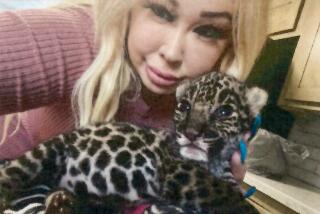New Program Helps Raise Money for Care : Environmentalists Let ‘Foster Parents’ Adopt Birds, Animals
- Share via
Donna Castle’s fourth-graders in Milford, Pa., have adopted an injured red-tailed hawk named the Red Baroness. Nine-year-old Stephen Raba thinks of the hawk as his own.
“He talks about it all the time, about his bird. He takes it personally,” said his mother, Lynne Raba. “When some of the class went to see it, he was adamant that he had to go, that it was so important. It’s something that he takes a lot of pride in.”
The students at Dingman Delaware Elementary School recycled $25 worth of aluminum cans to adopt the bird for one month at a nearby rehabilitation center for injured and orphaned birds of prey. The children are hoping they can keep the Red Baroness on the mend until she’s ready to be released into the wild.
Elsewhere, financial foster parents are being sought for a manatee in Florida, baby puffins off the coast of Maine and California gray whales in the Pacific Ocean. A Pennsylvania trout stream can be adopted for an investment of labor, as can a Texas beach and an Arkansas highway.
Across the nation, environmental groups are offering “adoption” plans for wild birds and animals, their habitats and open spaces as a way to raise money anywhere nature is in trouble. The groups say more and more people are adopting the wild through contributions.
‘Hands-On’ Effort
“It’s hands-on. It’s strong and it’s powerful,” says Pat Noonan of the Conservation Fund in Washington, D.C.
“The environmental movement is trying to reach out in creative ways to enlist volunteer support and involvement, and adopt-a-tree and adopt-a-whale are things people can identify with.”
Jennifer Bates of the Whale Center in Oakland, Calif., one of several organizations offering whales for adoption, says: “It’s a gimmick, a hook, because everybody is hurting, everybody needs money. After you donate to a couple of organizations, chances are your mailbox is going to be inundated, so you want to be the one piece of mail folks will not throw out.”
Zoos and aviaries often sponsor adoption programs for both special projects and general upkeep, says Charles Wickenhauser of the Pittsburgh Zoo, which recently raised $6,500 to build a new penguin exhibit through a “penguin parents” program.
“I think the generation of baby boomers has less of a giving tradition than our parents did,” he says. “We’re trying to find the trigger for their giving and trying to find it in nontraditional ways--what unlocks the purse.”
Adoption rates range from $10 to hundreds of dollars. The money is used either directly--to buy housing, medical care and food for the adoptee--or indirectly, to subsidize research, species preservation, educational programs or lobby efforts.
In exchange, foster parents usually receive a glossy photograph and description of their animal, occasional updates about its comings and goings and, just like Cabbage Patch dolls, a certificate of adoption.
But adoptions don’t work for all environmental causes.
“You have to have something that’s there and identifiable, that you can photograph and put a name on,” says Craig van Note of Monitor Consortium of Conservation and Animal Welfare Organizations in Washington D.C.
“There’s no way you can really adopt an elephant in Africa. In a case like that, you’d have to tell the people their elephant got killed last week, and that would be a downer.”
Florida Manatees
A Florida native, Debra Brown, 33, of Orlando, was accustomed to seeing manatees swimming in the state’s shallow rivers.
But it wasn’t until she received an appeal to adopt “Boomer” that she became passionately involved in saving the gentle and fragile animals, most of whom bear scars from boat propellers.
“If something happened to Boomer, you’d probably find me in tears,” she says. “As big and, quote, ugly as manatees are, they’re beautiful.”
Since the Save The Manatee Club of Maitland, Fla., began offering adoptions in 1984, officials say membership has grown from 800 to 20,000 adults and about 60,000 students--80,000 foster parents in all trying to save a species whose population has dwindled to about 1,200.
“Boomer is a manatee who’s special to a lot of people now and if something happens to Boomer, there are a lot of people who are going to be upset,” says club director Judith Delaney Vallee. “It’s now their manatee.”
Adoptions have become the lifeblood of many organizations, which have been scrambling for funds since many charitable donations were declared no longer tax-deductible.
Thanks to whale adoptions, the Massachusetts-based International Wildlife Coalition, which monitors several endangered species, has grown from three employees in 1983 to 22 now. In the past year, the group sent out 86,000 humpback whale adoptions for $15 each, 50,000 of which were Christmas gifts.
“Our files grow faster than we can keep up with,” says coalition official Margaret King. “People will send it as a gift to someone else--it’s a great stocking stuffer. And it crosses all barriers and countries. We have people in Saudi Arabia, France, Australia who have adopted whales.”
Sixty-six humpback whales that migrate yearly to the Cape Cod area can be adopted. Individual whales are identified by unique white and gray marks on their tails, so foster parents receive a photograph of their whale’s tail as it breaches the water.
More to Read
Sign up for Essential California
The most important California stories and recommendations in your inbox every morning.
You may occasionally receive promotional content from the Los Angeles Times.










